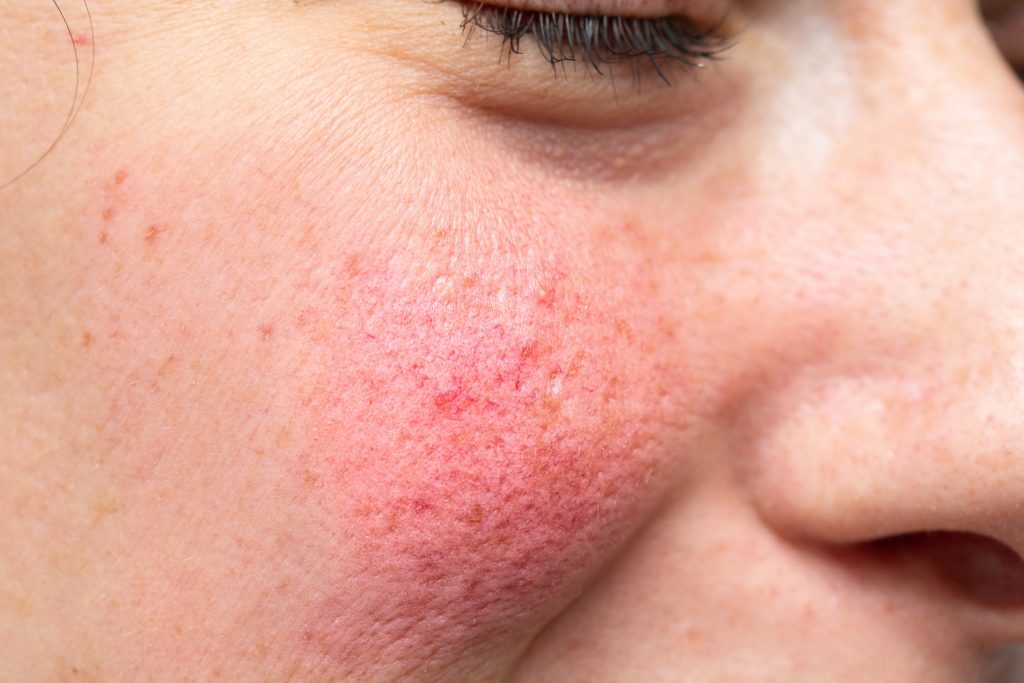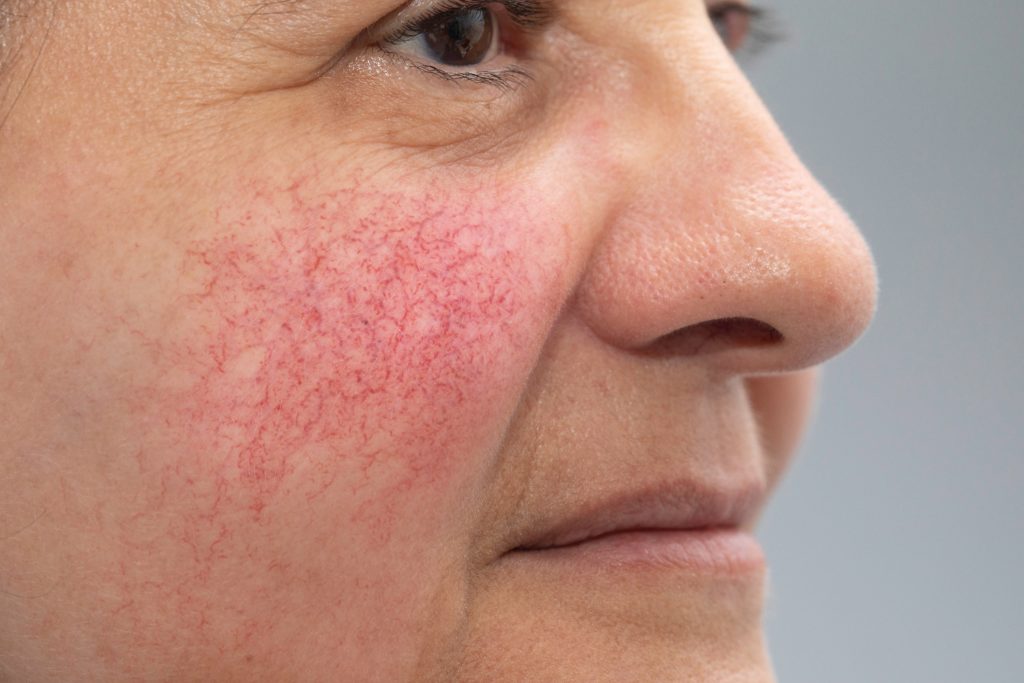Rosacea: Get the facts
Is your facial redness a form of rosacea? According to the National Rosacea Society, an estimated 16 million Americans suffer from symptoms and signs of rosacea, and up to 415 million worldwide — yet most of them are not aware of it. We hope that this article will help you to learn more about the signs, causes, and treatments of rosacea, so that you can determine how to manage it.
To get the facts, we sat down with one of our experts Patrick Rice, PA-C at GoldinSkin Dermatology.
What is Rosacea?
Rosacea is a common inflammatory condition that can go through periods of worsening and improvement (relapsing-remitting). There are a few subtypes of rosacea that have different presentations, each bringing with them their own set of concerns from patients and challenges for treatment.
What are the different types of Rosacea?
- Erythematotelangiectactic rosacea – The name is long and intimidating, but all it means is that there is redness, flushing, and visible blood vessels at the surface of the skin.
- Papulopustular rosacea – This type can closely resemble acne. It is characterized by red papules and pustules that resemble acne pimples.
- Ocular rosacea – This type affects the eyes. Eyes may become bloodshot, feel dry, irritated, swollen, and can cause redness around the eyelids.
- Rhinophymatous rosacea – This is a rare form that is more common in men than in women. It can cause thickening of the nose skin.


Who gets rosacea?
Rosacea most commonly affects fair skinned individuals. It usually occurs for the first time between the ages of 30 and 50 and is more commonly seen in women than in men, though men will often have more severe cases, including rhinophyma. However, anyone can get rosacea.
There may be a familial component to rosacea, meaning that if you have parents or siblings with rosacea or severe acne, you may be at greater risk for having rosacea.
Triggers for rosacea tend to be different for each person. Common triggers for flares include spicy foods, caffeine, alcoholic beverages, cold wind, and sunlight. You may notice other activities that cause a flare up.
What is the difference between rosacea and acne?

Rosacea has many subtypes as we discussed earlier. The papulopustular version is most commonly confused with acne. The main differences between these conditions are the timing of the onset of the condition, the pattern of flaring, the locations, and types of lesions. Acne will often have comedones, commonly known as “white heads” and “black heads”, whereas rosacea typically does not.
What are the symptoms and where on the body does rosacea appear?
Rosacea appears almost always on the face. Symptoms vary, but most often there will be redness and papules on the cheeks and/or nose. In some cases, the nose thickens and/or painful cystic lesions develop. The chin and forehead are less common areas where rosacea appears, though it does happen. Occasionally it can affect the neck and upper chest as well. In ocular rosacea, the eyes and eyelids are affected causing redness and sometimes swelling.
How is rosacea diagnosed?
Rosacea is a clinical diagnosis that we can make from the current presentation (what we see when we examine you), therefore it is best to schedule an appointment with us during a flare up. It is helpful to take photos when you are at your worst, and of course be able to provide us with your health history. There is typically no need for biopsy when diagnosing rosacea.
Can flare ups be prevented?
Yes, when managed properly flare ups can be avoided though it can be difficult. Our goal is to find a daily regimen in which triggers, and causes can be avoided and therefore flare ups may be more easily prevented. Finding your specific triggers is extremely important, however I always tell my rosacea patients to:
- Avoid direct sun exposure – always wear sunscreen to protect their faces when outdoors because sunlight is a common trigger. Limiting sun exposure, wearing a hat with a wide brim, and using sunscreen are all things that should be incorporated into your routine especially during the warmer months.
- Stick to a simple skin care routine – once we find a maintenance plan that works for you, we want to ensure you are sticking to that plan as many products may contain skin irritants, especially exfoliants.
Other triggers may include extreme heat and/or extreme cold. I tell my patients to try to exercise in a cool environment to prevent overheating, and always wear a scarf and cover your face in the winter months. Alcohol, caffeine, and spicy foods are also common triggers. Keeping a log of flare ups and potential associated triggers can help to determine the causes, and therefore help us develop your treatment plan.
Is there a cure for rosacea?
There is no cure for rosacea. It is a condition in which you will have good days and bad days, good weeks and bad weeks, and even good months and bad months. When we manage rosacea, we think about getting it under control and providing you with the simplest routine in order to do that.
How is rosacea treated?
Treatment of rosacea is not “one size fits all”. It will involve finding your specific triggers and finding an effective treatment for you that may consist of topical and/or oral medications. It will also depend on the subtype of rosacea that you have. We would create a plan and revise it to get you to the simplest treatment that is effective for you.
References:
National Rosacea Society ‘All About Rosacea’ https://www.rosacea.org/ accessed 2/24/2021
- Gallo RL, Granstein RD, Kang S, et al. Standard classification and pathophysiology of rosacea: The 2017 update by the National Rosacea Society Expert Committee. J Am Acad Dermatol 2018 Jan;78(1):148-155.
About Patrick Rice, PA-C

Patrick Rice is a native of the northwest side of Chicago. He completed his Physician Assistant training in 2016 with a master’s degree in Medical Sciences at the College of Health Sciences at Midwestern University in Glendale, Arizona before joining the GoldinSkin Dermatology team in October 2016.
In 2009, he graduated with a degree in Industrial Engineering and Management Sciences from Northwestern University’s McCormick School of Engineering. He then worked for a healthcare consulting company for two years before beginning his path to become a Physician Assistant.
Patrick enjoys seeing patients and treating a variety of skin conditions including rosacea, acne, eczema, psoriasis, skin cancer screenings, warts, and more. He is a member of the American Association of Physician Assistants and the Society of Dermatology Physician Assistants.
Click here to schedule an appointment with Patrick.

